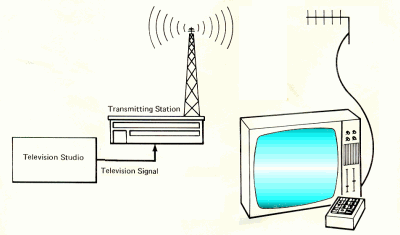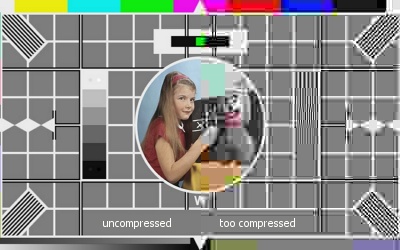Do I need to buy a booster?
 Brian Butterworth published on UK Free TV
Brian Butterworth published on UK Free TV With analogue television, it has often been necessary to buy an amplifier to improve the quality of the television picture, or to supply a steady on several televisions fed from the same aerial.
Many people have asked if it necessary to investing in a signal booster for Freeview.
"Analogue television" means is that the sound and pictures are broadcast using signals that are an "analogue" of the input. The sound and picture are transmitted from the source as electrical signals, then as radio waves and then back to sound and picture again.
In an analogue television camera, the image is scanned 25 times a second from side to side, from top to bottom and back. Where a lot of light is scanned, a high voltage is produced. Where no light is scanned, no voltage is produced. The output voltage is the same ratio to amount of light at scanned.
Leaving aside the technically, this signal is sent to the transmitter. The transmitter emits a radio wave on a known frequency, which is varied by the incoming voltage.

A microphone also converts the sound vibrations it picks up into a voltage, which when sent to the transmitter is added to another radio transmission frequency.
The signals are received by a television aerial pointing at the transmitter and converted back to very weak electrical signals. The sound is amplified and sent to a loudspeaker, and a picture created on the TV screen.
So on an analogue television, if the incoming signal is weak then the picture is dull as the background noise (the snow scene seen when an analogue television is not tuned) makes the picture less watchable.
The best analogue television set equipped with a great TV aerial located near to a high powered transmitter will produce brilliant pictures and clear sound. A poor set with an inadequate aerial or substandard cable will not.
If a weak signal is fed to a booster device, this will make the picture appear better on the television set or sets. It is often worth the investment.
Digital television
In a digital studio, the voltages from the cameras and microphones are not sent directly to the transmitter. It is converted into a stream of numbers inside a computer. The input voltage relates directly to the number in the computer. By sampling the input at a regular frequency, it is therefore possible to both store and transmit the information digitally this is what computers are good at.
It is therefore possible to take these numbers and generate a sound and picture output from them. However, the amount of information generated is over 240Mb/s, 30 times the rate of the fastest broadband connection.
Buy using computational techniques on this information the data can be compressed to as low as 2Mb/s, with as little as 6Mb/s being required for a good quality picture. These data compression techniques are called "lossy" because the reconstructed images are not identical to the originals, but look virtually similar to human eyes.

Digital television uses the same transmission frequencies as analogue uses, known as C21 to C68. The digital data is sent using a system called COFDM (Coded Orthogonal Frequency-Division-Multiplexing) which can carry data at a rate of 18Mb/s or 24Mb/s. Several television channels and some radio stations can be multiplexed together to produce exactly this amount of data.
At the receiver, it must be able to decode every single bit from these transmission multiplexes. A single error is impossible to correct for, so the decoder must have no errors.
Until switchover happens, the Freeview signals are being broadcast at very, very low power levels. However the COFDM system and sensitive digital equipment will, as long as the signal can be found and decoded there will be pixel-perfect reconstruction of the television channel. If the signal is drowned out by interference (especially from analogue transmissions) then no picture or sound will be output.
If the TV aerial installation you have provides you with all the Freeview channels, there is nothing to worry about.
If you are missing some channels because the signal is just too weak the best place to start is by improving the aerial, see Freeview reception - All about aerials. A bigger, higher, better designed aerial will always be the most sensible way to get perfect reception.
If you want to supply a signal to several sets, where the incoming signal is being "split" to serve several Freeview boxes, a masthead amplifier will be effective. This is because the signal is already of good quality and is being repeated for several sets.
However, if you are not getting a good signal from your aerial, a booster by the TV set will probably not help as this will simply boost the background interference as much as the Freeview signal.
In circumstances where an amplifier that has improved a picture on an analogue, it may be unsuitable for Freeview reception. Sometimes they will block one or more multiplex, where disconnecting the amplifier will restore the channels.
Mark: Try and establish whether it affects other tennants, checking that it is Freeview they are using and not a satellite or cable service.
And try swapping the aerial lead which connects the TV to the wall socket.
| link to this comment |
6:37 PM
Deal
Mark: I only moved in last month so have no idea there lol..HD channels are there but drop out a lot
| link to this comment |
Mark's: mapM's Freeview map terrainM's terrain plot wavesM's frequency data M's Freeview Detailed Coverage
6:49 PM
Deal
All the other tenants are relatively old, it is a council owned property, and the aerial lead is brand new and recently changed twice. It is a long cable run 10 metres from socket to TV. I receive approx 67 TV channels (although not all can be viewed due to drop outs)
| link to this comment |
Mark's: mapM's Freeview map terrainM's terrain plot wavesM's frequency data M's Freeview Detailed Coverage
8:19 PM
Dave Lindsay : Have you recently had any occasion to use Megalithia's terrain indicator? and should you have did you find any problems with it? the reason I ask is from about a week ago it has continually failed with me at the point where after having entered the necessary data pressing "go" results in a site called "Host Gator.com" jumping in thereby making it impossible to pass this point.
I just checked it again a few minutes ago using Marks location for reference and the situation is still the same, therefore to save me endless checking I would be much obliged if you could give it a quick check and report your findings.
Cheers / JB.
| link to this comment |
jb38: Yes. It returns Error 500: "internal server error". I used it a week or so ago and I remember it did the same then.
| link to this comment |
8:28 PM
Dave Lindsay: Many thanks for your speedy response, and as you will most probably have guessed I was hoping that you would say that!
| link to this comment |
8:50 PM
hi
just moved to high wycombe, bedford uni, no aerial points, bort indoor aerial, no use, any advice
| link to this comment |
10:18 PM
phil: Generally, indoor aerials only work in areas of high signal strength. What's the postcode, so we can check the predicted signal?
| link to this comment |
10:46 AM
Hi,
We are having trouble with the TV breaking up we have a loft earial and a booster to one TV. We have tried moving the earial makes it worse. Do you think we need a new aerial or booster. Post code RH11 Crawley west susex.
Any help gratefully received,
Yvonne
| link to this comment |
1:04 PM
Yvonne: Check your signal level - your not a huge distance from Crystal Palace/Midhurst, and even with a loft aerial, your signal might be fine without the booster. If you can, bypass the booster, and see what your signal strength is.
See here: Freeview signals: too much of a good thing is bad for you | Digital switchover | ukfree.tv - 11 years of independent, free digital TV advice
A full postcode would be helpful, and the transmitter your using.
| link to this comment |